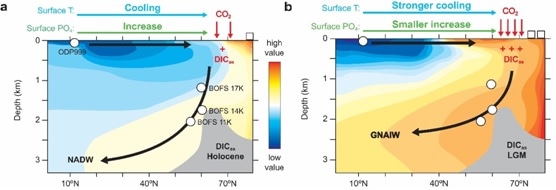May 20 2019
As per Antarctic ice core records, the concentration of CO2 in the atmosphere during the Last Glacial Maximum (~20,000 years ago) was approximately 100 ppm lower compared to the current warm interglacial known as the Holocene (~10,000 years ago to A.D. 1850).
 Schematics to illustrate more efficient atmospheric CO2 uptake during the Last Glacial Maximum (LGM) than during the Holocene. (Image credit: Yu et al.)
Schematics to illustrate more efficient atmospheric CO2 uptake during the Last Glacial Maximum (LGM) than during the Holocene. (Image credit: Yu et al.)
Gaining insights into the processes that caused the past atmospheric CO2 changes is important. This could also help to limit the carbon cycle and climate changes in the future.
The current opinion is that suppressed outgassing of CO2 in the Southern Ocean is the solution to reducing atmospheric CO2 during ice ages. Similar to other systems, the concentration of atmospheric CO2 is controlled by CO2 losses (for example, by North Atlantic absorption) and CO2 gains (for example, by Southern Ocean outgassing). But the sign of changes in past North Atlantic CO2 uptake efficiency remains unrestrained, limiting the understanding of the entire system.
Scientists from China, Australia, the United Kingdom, and the United States developed a new approach to evaluate the air-sea exchange component CO2, changes in which are directly connected to the variations in atmospheric CO2. They discovered that absorption of CO2 in the North Atlantic was about two times as efficient during the Last Glacial Maximum than the Holocene.
The outcomes of the study titled “More efficient North Atlantic carbon pump during the Last Glacial Maximum” have been published online in Nature Communications on May 15th, 2019.
This new estimate, related to geochemical data from multiple sediment cores, showed an extra ~100 gigaton sequestration of carbon by the North Atlantic during the Last Glacial Maximum, which is comparable to a decrease of ~50 ppm atmospheric CO2. This emphasizes a key role of the North Atlantic in carbon sequestration in the glacial deep ocean.
A greater high-latitude cooling and enhanced nutrient utilization could be responsible for more efficient glacial CO2 absorption in the North Atlantic, but further studies are required to figure out the exact mechanisms.
Jin Zhangdong, Professor, State Key Laboratory of Loess and Quaternary Geology (SKLLQG), Institute of Earth Environment, Chinese Academy of Sciences (IEECAS)
According to Dr Zhang Fei from SKLLQG, since it has long been suggested that the Southern Ocean is a significant region that influences atmospheric CO2 changes, the use of the new approach to estimate past air-sea CO2 exchange in the Southern Ocean has gained considerable attention.